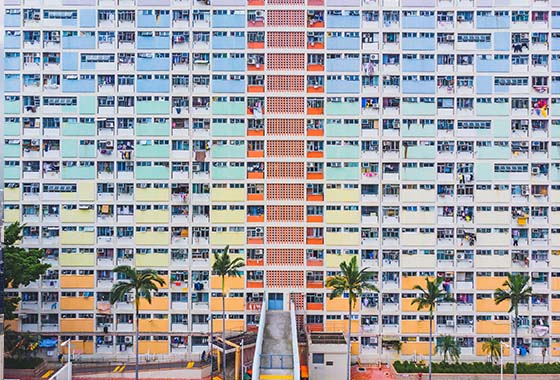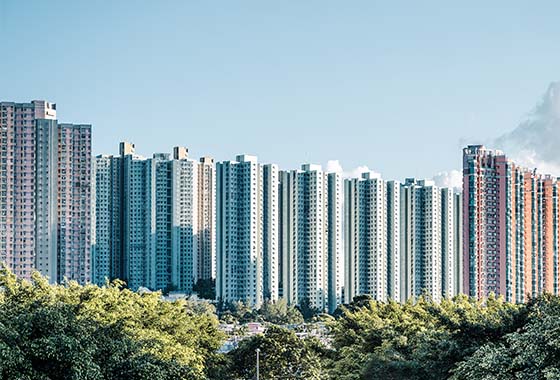A closer look into the subdivided flat issues reveals 3 local policy weaknesses
Authors: Ryan Ip, Head of Land and Housing Research, and Calvin Au, Assistant Researcher at Our Hong Kong Foundation

[Read related report - Decisive Moment — Can Hong Kong Save Itself from the Land and Housing Supply Crisis? ]
[Read related report - Building a Global City of the Future – Envisioning Sustainable Urbanisation of the New Territories]
[Read related report - Vision of Universal Affordable Housing in Hong Kong]
Lurking in the dark corners of Hong Kong for a long time, subdivided flats have become a prioritised issue under the spotlight of local policies in recent years. A few measures have been implemented by the Government as temporary relief, including transitional housing, cash allowance for public rental housing applicant households and rent control for subdivided units. However, when it comes to permanently eradicating the problem, the authorities only vaguely promised to solve it by 2049, which leaves grassroots with no hope but to sigh. The lack of effective solutions and a clear schedule is probably due to insufficient understanding towards the crux of the problem, leading to the failure in tackling the issue. We believe that the root causes of subdivided flats are attributed to three deep-seated social problems – housing shortage, a spatial mismatch between jobs and housing, and the wide income gap. These knotty issues are interconnected, but each of them is an urgent case that does not allow further procrastination.
Inadequate public housing supply is usually associated with the problem of subdivided units. Nonetheless, the impact caused by the shortage of private housing supply cannot be overlooked. Among the 110,000 subdivided units, quite a number of households are not eligible for public housing as their income exceeds the limit. They are stuck in a quagmire, unable to own a flat or afford the rent of respectable flats. With regard to the housing supply deficit, we have pointed out in our studies multiple times that the Government has yet to meet the targets of public and private housing supply in the past 8 years, with over 120,000 units unfulfilled. To fill the gap, 300,000 units are needed in the coming 5 years. We suggest that the Government should streamline procedures to expedite construction and shorten the time needed for land resumption, designing and works by untangling the complexities in the consultation process. Private sector participation should also be fostered in the construction of public housing so that some of the 230,000 units originally scheduled to be finished between 2026 and 2030 can be completed earlier.
Home-job balance is of equal importance. Currently, nearly 90% of the subdivided units are situated in metropolitan districts, i.e. the Hong Kong Island, Kowloon, Tsuen Wan and Kwai Tsing. The living environment of these units is cramped, but the rent per square meter is nearly 40% higher than that of the small units in the New Territories (N.T.). Residents of subdivided flats are resigned to the high rent to live closer to their workplace. In this way, commuting time and expenses can be saved, thus they can extend their working hours to earn more. In other words, without ample job opportunities, a surge in housing supply in the N.T. is not enticing enough to attract subdivided flat residents. Lamentably, home-job balance has become a hollow slogan. With reference to Population Census in 2006 and 2016, less than 25% of local citizens work in the non-metropolitan districts in the N.T., where 40% of the population reside. This predicament has lasted for over a decade. We urge the Government to enact industrial policies to speed up the planning for modern logistics, professional services, and innovation and technology industries in the Northern Metropolis. The formation of high value-added industry groups can then stimulate the job chain of the neighbouring service sector.
Stimulate the job chain through the Northern Metropolis
In fact, poverty is the major root cause of the proliferation of subdivided flats. Even if the Government can drastically increase job opportunities and public housing supply for the grassroots, the wealth gap issue cannot be completely resolved. Family wealth in Hong Kong is decided by the opportunity to own a flat. As the rise in income can never keep up with the rise in property prices, the ultimate goal of residents for both subdivided units and public housing is to become a flat owner so as to achieve upward mobility through the appreciation in property prices.
Similarly over-populated with limited land, Singapore does not witness a surge in sub-divided flats. Over 70% of families have bought public housing at low prices, living in constant peace, stability and prosperity. Thus, it is our belief that re-launching the Tenants Purchase Scheme plays a pivotal role in eradicating subdivided units and poverty by offering most families a chance to buy public housing at an affordable price. This can bring improvements to Hong Kong’s housing market structure which is currently dominated by public rental housing and private housing.



